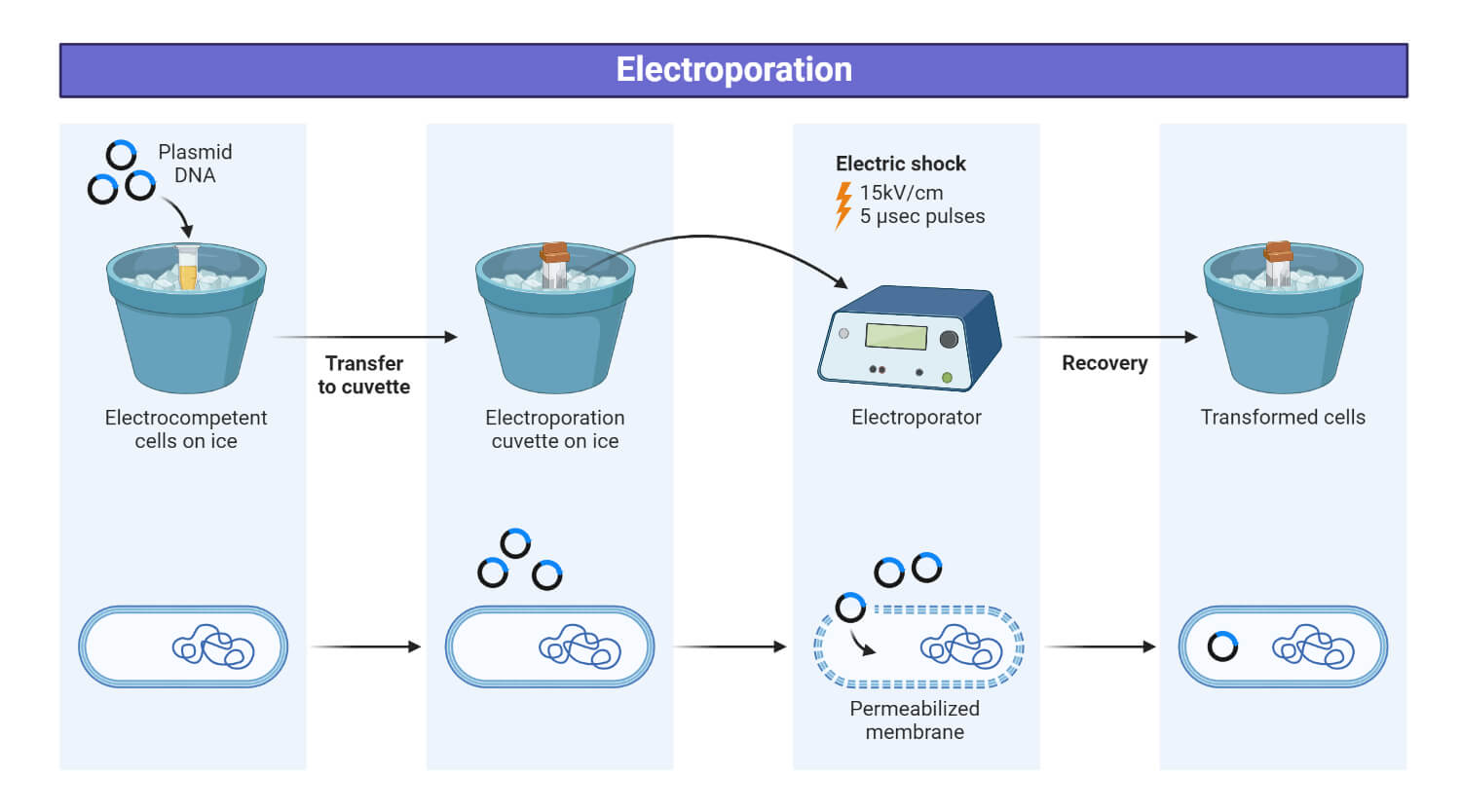Electroporation, also called electropermeabilization (EP), is a physical method of introducing genetic material, proteins, drugs, or other desired molecules into cells for various purposes with the application of electric pulses to create temporary pores in the cell membrane, delivering the molecules to the cells.

Neumann et al. first introduced the concept of electroporation in 1982. Over the past few decades, electroporation has made significant advancements. Initially, it was limited to simple in vitro experiments. It can now be used in gene transfer, gene therapy, drug delivery, and various in vivo therapeutic approaches.
Interesting Science Videos
Principle of Electroporation
The working principle of electroporation involves applying electric pulses to cells, which creates temporary pores in the cell membrane. These pores allow the entry of molecules, such as DNA, proteins, drugs, and other substances, into the cells.
The application of electric pulses to cells causes disruption of the cell membrane. The pulses change the electrical potential across the membrane, leading to the formation of temporary pores in the phospholipid bilayer that forms the cell membrane. These pores allow molecules to pass through the membrane.
Once the electric pulse is turned off, the pores start to close and the cell returns to its normal state. Some of the molecules taken up by the cell are trapped inside as the membrane reseals. If the electric field allows the membrane defects to reseal, it is reversible electroporation, while if the defects persist, it is irreversible electroporation, leading to cell death.
Once the molecules enter the cells through the temporary pores, they can interact with the cellular mechanism, influencing cellular processes and functions.

Steps of Electroporation
The specific steps and materials involved in electroporation may vary based on the cell type, and electroporation equipment. The steps below provide a general overview of the electroporation process.
- Prepare the cells for electroporation:
- First, the cells of interest are cultured and grown to the desired growth phase.
- Then the cells are harvested by centrifugation and resuspended in an appropriate electroporation buffer.
- The DNA or other molecules of interest are also prepared. This may involve isolating and purifying the DNA or preparing a solution of the desired molecules.
- Electroporate the cells:
- The cell-DNA mixture is transferred into an electroporation cuvette, which is a specialized chamber designed for electroporation.
- The cuvette is placed in the electroporation device called an electroporator.
- An electric pulse is applied to the cells by activating the electroporation device.
- Recovery of cells:
- After the electroporation pulse, the cuvette is immediately removed from the electroporation device.
- Then the cells are allowed to recover briefly at room temperature or on ice before being transferred to a normal cell growth medium. During this time, the cell membranes reseal, and the introduced molecules are incorporated into the cells.
- Culture and harvest the transfected cells:
- Finally, the transfected cells are cultured and harvested.
- After the recovery period, the cells are transferred from the cuvette to a suitable growth medium that promotes their survival and growth.
- The cells are incubated under appropriate culture conditions based on the experimental requirements.
Applications of Electroporation
Some major applications of electroporation are:
- Electroporation is widely used in the transformation of bacterial cells to make them competent and capable of taking up foreign DNA for various purposes like recombinant protein production, cloning, and other biotechnological applications.
- Electroporation is also used in transfection. Similar to bacterial transformation, electroporation allows the manipulation of eukaryotic cells by engineering their genetic material.
- Electroporation is widely used in genetic engineering to introduce foreign DNA into cells. For example, it can be used for the transformation of plant cells, allowing the introduction of foreign DNA into plants for crop improvement.
- Electroporation can be used for delivering drugs and vaccines. It allows the delivery of large substances that cannot easily cross the skin. DNA vaccines against various diseases, such as plague, and SARS-CoV-2, have also been developed using electroporation as a delivery method.
- Electroporation is also used in gene therapy to deliver modified or additional genetic material.
- Irreversible electroporation is used in the treatment of cancer. This method uses high-voltage electric pulses to cause permanent damage and cell death in tumors.

Advantages of Electroporation
- Electroporation is a versatile method that can be used in various cell types, including bacteria, yeast, plant cells, and mammalian cells.
- Electroporation can be used to deliver genetic material into cells that are difficult to transfect.
- Electroporation provides consistent and reproducible results.
- Electroporation does not require the use of vectors for gene transfer. It is a safe and non-toxic method.
Disadvantages of Electroporation
- High-voltage electric pulses used in electroporation can cause cell damage or cell death if the parameters are not optimized.
- Electroporation requires specialized equipment, including an electroporator, cuvettes, and appropriate voltage settings.
- Electroporation may lead to variable transfection efficiency. Some cells may take up the introduced molecules more efficiently than others.
- Very large DNA fragments or complex structures may not be efficiently delivered into the cells.
- Cells are delicate following electroporation and must be treated carefully during recovery to avoid cell death.
References
- Carter, M., & Shieh, J. (2015). Gene Delivery Strategies. Guide to Research Techniques in Neuroscience, 239–252. doi:10.1016/b978-0-12-800511-8.00011-3
- https://www.technologynetworks.com/cell-science/articles/an-introduction-to-electroporation-a-tool-for-transfection-and-competent-cell-generation-363195
- https://www.thermofisher.com/np/en/home/references/gibco-cell-culture-basics/transfection-basics/methods/electroporation.html
- Kotnik, T., Frey, W., Sack, M., Haberl Meglič, S., Peterka, M., & Miklavčič, D. (2015). Electroporation-based applications in biotechnology. Trends in Biotechnology, 33(8), 480–488. doi:10.1016/j.tibtech.2015.06.002
- Potter, H., & Heller, R. (2003). Transfection by Electroporation. Current protocols in molecular biology / edited by Frederick M. Ausubel … [et al.], CHAPTER, Unit. https://doi.org/10.1002/0471142727.mb0903s62
- Shirley, S. A., Heller, R., & Heller, L. C. (2014). Electroporation Gene Therapy. Gene Therapy of Cancer, 93–106. doi:10.1016/b978-0-12-394295-1.00007-x
- Yarmush, M. L., Golberg, A., Serša, G., Kotnik, T., & Miklavčič, D. (2014). Electroporation-Based Technologies for Medicine: Principles, Applications, and Challenges. Annual Review of Biomedical Engineering, 16(1), 295–320. doi:10.1146/annurev-bioeng-071813-104622
